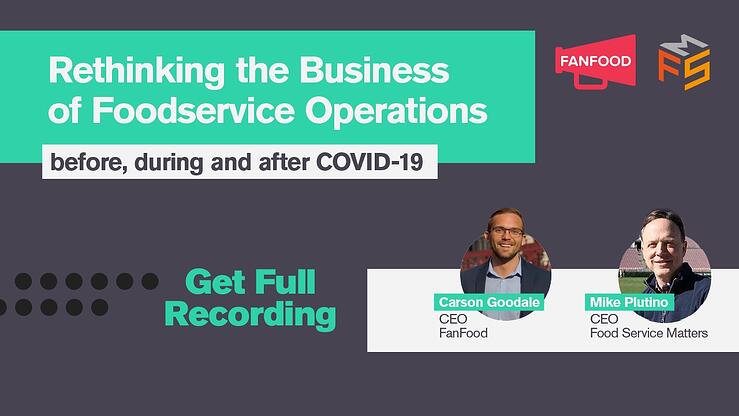Rethinking the Business of Foodservice Operations in 2020
Last Thursday we concluded our livestream on the topic of “Rethinking the Business of Foodservice Operations”, hosted by Carson Goodale, CEO of FanFood and Mike Plutino, CEO of Food Service Matters.
The business of foodservice will never be the same. Some challenges have been magnified by COVID-19, such as staffing and fulfillment. However, new opportunities also arose: consumers are more open to technology, and new business models have emerged to increase profitability.
If you’d like to see a full recording of the webinar, please visit the page here.

What were foodservice operations like before COVID-19?
Back in 2019, FanFood published a blog on 3 factors that make or break the fan experience, and F&B services was high on the list. Be it at event facilities, restaurants or hospitality venues, food has always been a major factor influencing the customer experience.1. Second most important influencer of the customer experience.
With perhaps the exception of restaurants, drive-in theaters and some hospitality venues, foodservice hasn’t been a main driver of revenue, especially at live events. In the realm of sports, other revenue generators include season tickets, merchandise and luxury suites; whereas traditional concession stands have been struggling with thin margins and slow fulfillment. However, customers’ satisfaction with the foodservice affects their overall experience, which in turn affects how willing they are to spend in other areas. After all, it is the second most important factor in fan experience and has always been a fascinating point of debate among the most avid fans.2. The single biggest challenge in foodservice operations is staffing.
Most of the food or concession stands are operated by temp staff or even volunteers, and filling up every shift slot has been a major headache for F&B managers. Instead of going out of your way to fill up the roster, it was time to think in the opposite direction: reduce the labor need and shrink the gap. Businesses and operations already started using a combination of kiosks and mobile ordering to eliminate the need for a cashier, and turn each F&B outlet into a fulfillment-based model where no manual order-taking or transaction is going on. That trend, as we will discuss later, has only been accelerated by COVID-19.3. Mobile ordering was a “nice-to-have”.
The adoption rate of F&B mobile ordering hasn’t been uniform across different industries. In the restaurant space, mobile represents 60% of all digital restaurant orders today, whereas in sports and live entertainment — where concession mobile ordering was still a relatively novel concept — the adoption rate is often in the single digit range.
Some stadiums went completely cashless in 2019 in order to provide a convenient and frictionless experience, where fans can order from their seats and skip the lines. However, in a post-COVID world, the ability to order and pay cashlessly is almost an expectation and no longer a luxury.
How can foodservice operators adapt in 2020?
1. Pursue a fulfillment-based model to reduce headcount.
If finding staff was difficult before COVID-19, it may well be even more so in the foreseeable future. Fewer people would want to work in high volume operations, confined to the limited space of a food stand or kitchen. This challenge will likely remain for as long as a vaccine is not discovered. That means the limited number of staff needs to all focus on fulfillment, and let technology handle the rest. Mobile ordering has turned everyone’s phone into a “POS in the pocket”, where people can place orders and pay on their phone without having to interact with anyone. Not only will this reduce cost of labor and hardware (POS), it also increases efficiency and margin of operations.
FanFood online and mobile ordering where people can purchase in app or in their browser.
2. Maximize the benefits of mobile ordering.
Our data has shown that orders place on the FanFood platform have been on average 40% larger than traditional walk-up orders, and multiple of our partners have spoken about how mobile ordering increased their average order value and revenue per cap. Mobile ordering is also the perfect solution for social distancing, which will likely be the guideline for operations for quite some time to come. Customers can scan a QR code to view full menu, then order and pay on their phone for contactless pickup and delivery. Throughout this process, there’s no need to interact with a server or pass around a physical item. The added bonus? This process is faster, easier and way more convenient. From the operators’ perspective, mobile ordering allows them to centralize order data and fulfill orders in a more streamlined manner. That means at the end of the day, they will have a better understanding of their customers’ purchase behaviors and predict their inventory better next time.
From the operators’ perspective, mobile ordering allows them to centralize order data and fulfill orders in a more streamlined manner. That means at the end of the day, they will have a better understanding of their customers’ purchase behaviors and predict their inventory better next time.
.jpg?width=960&name=July%20Webinar_%20Rethinking%20the%20business%20of%20foodservice%20operations%20(1).jpg)
3. The need for a business model shift.
The existing business model for foodservice operations was designed for facilities with traffic and attendance, which is no longer the case. Even though sports attendance was on the decline before the onset of COVID-19, that was still nothing compared to what attendance would look like in the future. Be it no fans in attendance or 25% capacity, it will be way worse than what we’ve ever experienced before. That means the incentive is higher than ever for F&B operators to reduce labor cost and increase margins, and re-evaluate all the numbers in order to increase profitability. For example, many existing deals may have to be re-negotiated to take into consideration the current economic climate. New technologies might have to be adopted because now its a better time than ever to take the leap (also, many offers are going on to facilitate the adoption. For example, you can get started with FanFood’s mobile ordering platform for free to try it out first.)
If you’d like to access the full live stream recording and get a copy of the presentation deck Carson used, please visit the page here.



